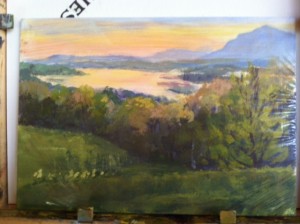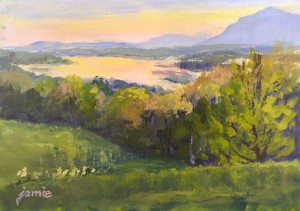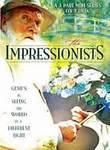
5×7″, acrylic on archival rag board
SOLD! Please email me at JamieWG@aol.com to inquire about a similar painting.
This was painted 99% on location at Olana, the estate of Hudson River School artist Frederic Church. Often after plein air painting, I get the painting home, and when I see it with indoor lighting, there is something that needs adjusting. Initially, the yellows in this painting were too cool compared to what the painting and scene looked like on location. It needed a glaze of warmer color. The image below is what it looked like when I brought it home. It looks a little anemic, don’t you think?

Glazes are quick to do, but can be tricky. Because acrylics dry so fast and cannot be removed when dry, laying on too much color while working transparently can suck all the light out of a painting. To be certain that I laid down the right color in the proportions I needed, I first covered the painting with clear plastic food wrap, and set it on the easel. With a mixture of Acrylic Glazing Liquid and transparent color, I tested the glaze color and result on top of the plastic-covered painting. If I wasn’t happy, I wiped it off and tried a different proportion or mix, until I got it looking the way I wanted while it was covered in the plastic wrap (click to enlarge):

Then I removed the plastic wrap from the painting, and set it against a white surface. This gave me a guideline of color and proportion of paint to glazing liquid, in order to achieve my desired result. It always surprises me how little color is needed when I see the glaze I used against a white surface! This is all that was needed to glaze this particular painting, so you can see how easy it would be to mix in way too much color (click to enlarge):

I then mixed the color and glazing liquid on a white paper palette to match the color on the plastic wrap, and painted it over the surface of the actual painting. It’s a pretty foolproof way to get exactly what you want! All that was left to do was to sign my name. Testing the glaze layer this way does take a few extra minutes, but it is well worth it in the end. It enables me to test many different options before making a commitment.
Acrylics have some truly wonderful properties, and definite advantages over oil paints. If I want to glaze an oil painting, I have to wait until the paint is quite dry. That’s a long time compared with the nearly instant glazing capability of acrylics. Plus, each additional layer of oil glaze is problematic. Oil painting mediums can darken, yellow and crack over time. The more oil and resin enter the paint film, the worse it is for the painting. One only needs to stroll through a museum to see first-hand how true that is. Restoration is expensive, and most private buyers don’t have a huge art conservation budget!
Acrylics, on the other hand, can be glazed forever with no compromise to the paint film. The acrylic medium is flexible and archival, and will not yellow, darken, nor crack over time. That means that if I decide to darken or intensify a glaze, I can always add another layer.
Here is an image of the finished painting that you can click on for a slightly larger, clearer view:

